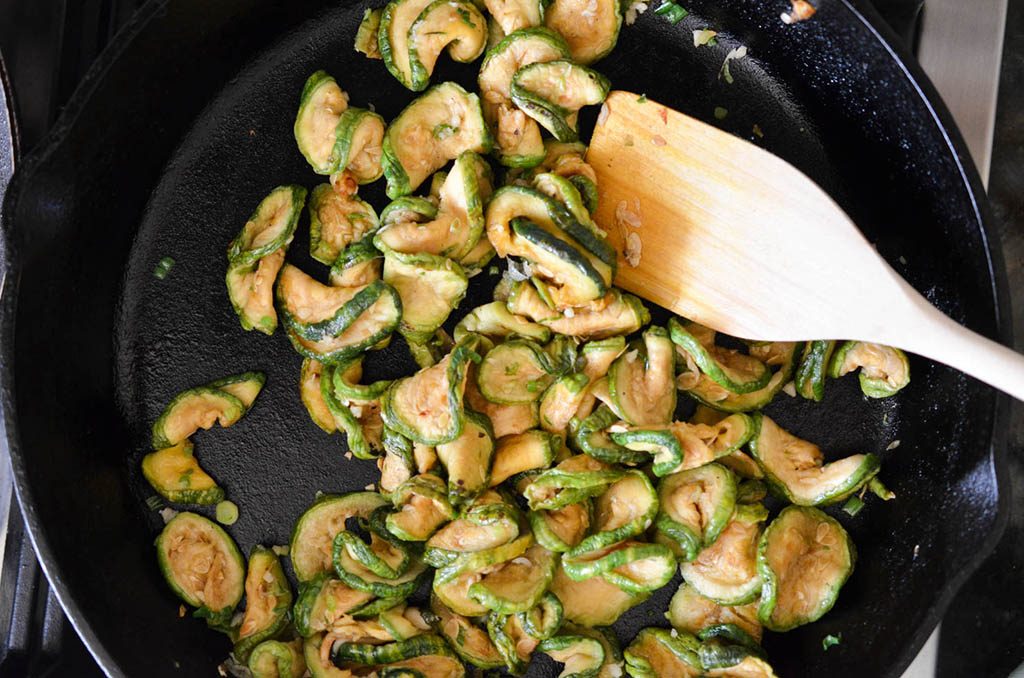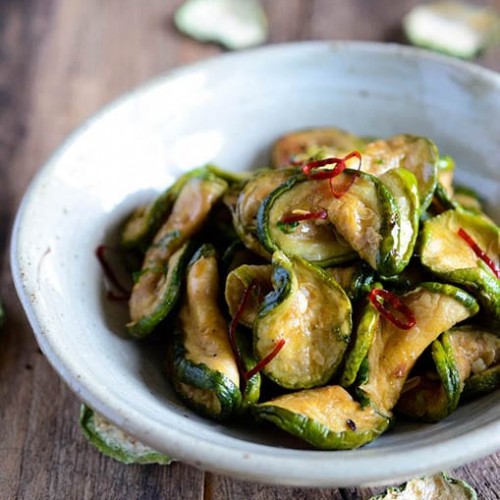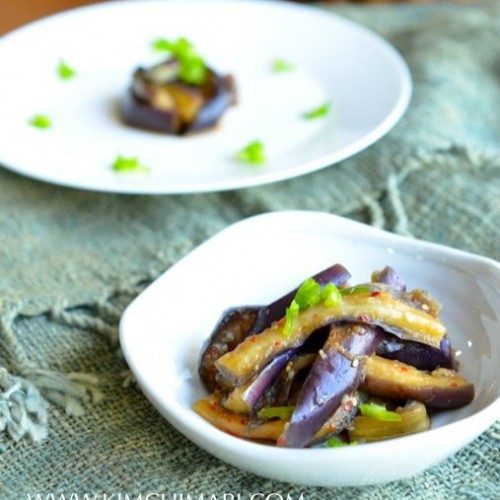
Healthy and also gluten free, my zucchini side dish recipe uses dried zucchini slices instead of fresh. In Korean, it is called Maleun hobak namul (마른호박나물 Maleun (마른) where maleun means “dried” and hobak(호박) means “zucchini/squash”. Maleun Hobak is also called Hobak Goji(호박고지) in some areas of Korea. This Korean zucchini side dish recipe is a relatively quick and easy dish when compared to other Korean dried namul that involves first boiling the dried vegetables in water and then letting it soak for hours before you can even start making the namul. You only have to soak this for 1 hour so that’s relatively quick. 🙂
Koreans love drying vegetables, fish, meat and fruit – that’s everything except dairy 🙂
Last summer when I had too many Zucchini’s growing in my garden, I had to do something with them besides giving them to friends and making Hobak Jeon, Hobak Gochujang Jjigae, and Hobak Buchimgae. (Clickable pictures below)



So, I decided to dry them – just like how my mom’s generation used to do. With Koreans, when you have too much of something, you dry them. Especially in the old days, Koreans were masters of drying produce: dried mushrooms (shitake, woodear, etc), dried bracken fiddleheads(고사리 gosari), dried bellflower roots(도라지 doraji), dried eggplant(가지 gaji), dried radish greens(시래기 shiraegi), dried radish (무말랭이 moo malaengyi), dried seaweed (김 gim) and then not just vegetables, Koreans made dried squid, dried fish, dried mussels,..I mean, I can go on forever..In the age before refrigerators and freezers, before green houses, Koreans collected and dried vegetables in the summer/fall and enjoyed them in all thru winter and into early spring.
Koreans even have a traditional holiday called 정월대보름(Jeongwol Daeboreum) which is celebrated on the first full moon of the first month of the lunar year. This year it will be 2/22/2016. On this day, among many things, our ancestors cooked 5 grain rice(오곡밥 Ohkokbap) and many namul dishes made from dried vegetables including dried zucchini namul. I wonder if it was also a way to make sure people got good nutrition during the long winter months. I will talk more about it later and perhaps dedicate a post on the traditional Daeboreum menu.
Dried vegetables have more intense flavor and great texture
So, as you may know from cooking with dried mushrooms, drying vegetables transforms the texture and flavor completely. The flavor of dried vegetables is usually much more intense and the texture is often more chewy. And if you know me, you know that I don’t really like mushy texture very much. In fact, I am not sure if I mentioned this before (hmm..maybe I’ve been blogging too many years…or maybe, just maybe, I’m getting a little old, haha) but unlike many Koreans, I am NOT a huge fan of raw fish or sashimi. When I eat raw fish, the mushy texture just prevents me from enjoying the flavor. I just want the thing one from my mouth – either back out or just by simply gulping it down…I know I’m strange..
Definitely, NOT a good thing when your mother-in-law is a sashimi lover. Once when we went on a trip with her to the Korean east coastal area and we went to a restaurant that served NOTHING but raw fish (회 Hwe). It was probably one of the most awkard, longest dinner I have ever had. She felt bad that I was not eating anything and kept telling me to try. She also kept mumbling to herself “I don’t understand.. why you don’t like this..it’s sooo good..” Hey, if it was now, after 25 years of being married, I would have said up front “Sorry, everyone, I don’t eat Hwe and I will meet you guys later. Enjoy~”. But I was still just a newly wed then and I simply did not have the heart and courage to tell her that I don’t eat Hwe when the whole purpose of the trip was to go and eat all these wonderful seafood. Well.. there are some good things that come with age… :))
Dried vegetables also have better nutrition – much higher in vitamin D!
Going back to Zucchini – so last summer, I sliced my zucchini and let it dry in the sun for a couple days. Since California is SOO dry in the summer, a couple days is all I needed.



In Korea, because it is humid in the summer, the time to dry vegetables is in the fall. Dried vegetables may lose some vitamins during the drying process but there is definite experimental evidence that vitamin D is dramatically increased after it is sun-dried. The wisdom of our ancestors sometimes just amazes me…
Here’s an excerpt from Paul Stamet’s great article on sun-dried mushrooms vs indoor dried mushrooms :
“The vitamin D levels in these (sun-dried) shitake mushrooms soared from 100 IU/100 grams to nearly 46,000 IU/100 grams (see chart). Their stems, though, produced very little vitamin D, only about 900 IU. Notably, vitamin D levels dropped on the third day, probably due to overexposure to UV.”
“Most interesting to me is that when we tested our mushrooms nearly a year after exposure, they preserved significant amounts of vitamin D2.”
So I did the BEST thing by drying it only for 2 days!!! How I know these things.. hahaha…
Grey zucchini is the closest one to Korean Aehobak (애호박) and that works best. If not, Italian Zucchini works too. You just need a thin skinned, tender summer squash or zucchini. If you just want to buy dried zucchini, you can probably buy them from your local Korean grocery store. In the bay area, both Hankook and Gyopo sell high quality Maleun Hobak (마른호박)/Hobak Malim(호박말림). I bought this one just in case:

FYI- Choroc Maeul(초록마을) is a big food brand name+franchise in Korea that sells mostly organic or high quality Korean groceries.
Great. Let’s get cooking, shall we?
Servings: 4 Prep Time: 1 hr Cook Time: 15 min Difficulty: Easy
Ingredients
- 100 g (4 oz) Dried Zucchini (grey or italian zucchini) Slices
- Seasoning
- 1 1/2 tsp Guk Kanjang (Korean soup soy sauce)
- 1 tsp mirin (cooking sake)
- 1/4 tsp sea salt
- 2 green onions, chopped
- 1 – 2 tsp chopped garlic
- 1 tsp perilla oil (들기름 Deulgireum) or substitute sesame oil
- 1 tsp sesame seeds
- Soak dried zucchini (마른 호박 maleun hobak) in warm water for 1 hr.
Dried Zucchini(Hobak Namul) soaking in water Dried zucchini after soaking in water for 1 hour - Strain zucchini slices and discard the water. Squeeze excess water from zucchini by squeezing them gently with your hands. Do not squeeze too much but just enough so that water is not dripping from them.
Dried Zucchini (Maleun Hobak) soaked and squeezed - Season rehydrated zucchini with guk kanjang, mirin and salt. Mix seasoning into zucchini by mixing them gently with your hands.
- Heat a pan with 1 tsp perilla oil (or sesame oil) and saute zucchini on medium heat for 2 min.
- Add garlic, green onions and 2-3 Tbs water (depending on how dry or wet you like it). There should not be much extra liquid when you are done.
Dried Zucchini seasoned and ready for saute in pan Saute for another 3-4 min. until zucchini slices are tender and seasoned. You can also brown it a little by sauteeing on med high heat. Add more 1~2 Tbs more water if you want more softer, more moist namul. Up to you.
Dried Zucchini Namul in pan - Taste and adjust seasoning if needed. Sprinkle sesame seeds.
Healthy Dried Zucchini Side Dish-Maleun Hobak Namul
Korean Dried Zucchini Side Dish that is healthy, delicious and so easy to prepare. Great on Bibimbap and in Fried Rice.Prep: 1 hourCook: 10 minutesTotal Time: 1 hour 10 minutesserves: 4Ingredients
- 100 g dried zucchini slice (4 oz, grey or italian zucchini works best)
Seasoning
- 1 1/2 tsp Guk Kanjang (Korean soup soy sauce)
- 1 tsp mirin (cooking sake)
- 1/4 tsp Sea Salt (Trader Joe's)
- 1-2 tsp chopped garlic
- 1 tsp perilla oil (들기름 Deulgireum or sesame oil)
- 1 tsp sesame seeds
Instructions
- Soak dried zucchini (마른 호박 maleun hobak) in warm water for 1 hr.
- Strain zucchini slices and discard the water. Squeeze excess water from zucchini by squeezing them gently with your hands.
- Season rehydrated zucchini with guk kanjang, mirin and salt. Mix seasoning into zucchini by mixing them gently with your hands.
- Heat a pan with 1 tsp perilla oil (or sesame oil) and saute zucchini on medium heat for 2 min.
- Add garlic, green onions and 2-3 Tbs water (depending on how dry or wet you like it). There should not be much extra liquid when you are done.
- Saute for another 3-4 min. until zucchini slices are tender and seasoned. You can also brown it a little by sauteeing on med high heat instead.
- Taste and adjust seasoning if needed. Sprinkle sesame seeds.
Tips & Notes:
Refrigerate any leftovers - it can spoil pretty quickly in the summer. Cooler months, OK for up to 1/2 day.
Korean Dried Zucchini side dish can be served both warm and at room temp.
Add to Bibimbap or Kimchi Fried Rice for wonderful texture and flavor.
Try adding soaked dried zucchini to your Deonjang Jjigae. It’ll be a treat!!Nutrition Information:
Calories: 21kcal (1%)| Carbohydrates: 1g| Fat: 1g (2%)| Sodium: 224mg (10%)| Potassium: 65mg (2%)| Vitamin A: 50IU (1%)| Vitamin C: 4.7mg (6%)| Calcium: 9mg (1%)| Iron: 0.2mg (1%)
JJ’s Tips
- Enjoy your Korean dried zucchini side dish warm or at room temperature.
- Can store in fridge for few days and reheat in pan or quickly in microwave.
- Great addition to Bibimbap or Fried Rice. In fact, I recently made Kimchi fried rice with leftover hobak namul and it was great! It added a great chewy texture to the fried rice.
- Also try adding soaked dried zucchini to your Deonjang Jjigae. It’ll be a treat!!
- If you have a dehydrator, you can dry your own zucchini slices now and enjoy it sooner than later. I found a great Italian dried zucchini recipe that talks about using the dehydrator to dry zucchini.
Dried Zucchini side dish – Korean maleun hobak namul
ENJOY your Hobak Namul and vitamin D!
take care,
JinJoo



























Oh! Of course you have this recipe! This is my all time favorite namul! Next time im at h-mart i will pick up a bag of the dried ones. I have no patience for drying my own 😊 ps. Love the website rebuild!
yum; can’t wait to make this! I have everything except the dried squash… which I will make soon! it’s hot here in Texas. my Korean squash is coming in… soon!